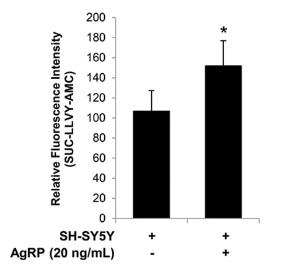Recombinant Human AGRP protein(Met1-Thr132), His-tagged
| Cat.No. : | AGRP-191H |
| Product Overview : | Recombinant Human AgRP (NP_001129.1) (Met 1-Thr 132) was expressed in HEK293, with a polyhistidine tag at the C-terminus. |
| Availability | April 21, 2025 |
| Unit | |
| Price | |
| Qty |
- Specification
- Gene Information
- Related Products
- Case Study
- Application
- Download
| Species : | Human |
| Source : | HEK293 |
| Tag : | His |
| Protein Length : | 1-132 a.a. |
| Form : | Lyophilized from sterile PBS, pH 7.2. Normally 5 % - 8 % trehalose, mannitol and 0.01% Tween80 are added as protectants before lyophilization. |
| Molecular Mass : | The recombinant human AgRP consists of 123 amino acids and has a calculated molecular mass of 14 kDa. The apparent molecular mass of rh AgRP is approximately 16-19 kDa in SDS-PAGE under reducing conditions. |
| Endotoxin : | < 1.0 EU per μg of the protein as determined by the LAL method |
| Purity : | > 90 % as determined by SDS-PAGE |
| Storage : | Samples are stable for up to twelve months from date of receipt at -20°C to -80°C. Store it under sterile conditions at -20°C to -80°C. It is recommended that the protein be aliquoted for optimal storage. Avoid repeated freeze-thaw cycles. |
| Reconstitution : | It is recommended that sterile water be added to the vial to prepare a stock solution of 0.2 ug/ul. Centrifuge the vial at 4°C before opening to recover the entire contents. |
| Gene Name | AGRP agouti related protein homolog (mouse) [ Homo sapiens ] |
| Official Symbol | AGRP |
| Synonyms | AGRP; agouti related protein homolog (mouse); agouti (mouse) related protein; agouti-related protein; Agrt; ART; ASIP2; AGRT; |
| Gene ID | 181 |
| mRNA Refseq | NM_001138 |
| Protein Refseq | NP_001129 |
| MIM | 602311 |
| UniProt ID | O00253 |
| ◆ Recombinant Proteins | ||
| AGRP-890H | Active Recombinant Human AGRP | +Inquiry |
| AGRP-814M | Recombinant Mouse AGRP Protein (Ser82-Thr131), HlgG1 Fc-tagged | +Inquiry |
| Agrp-553M | Recombinant Mouse Agrp Protein, MYC/DDK-tagged | +Inquiry |
| AGRP -63H | Active Recombinant Human Agouti Related Protein | +Inquiry |
| Agrp-6781M | Recombinant Mouse Agrp protein, His-tagged | +Inquiry |
| ◆ Cell & Tissue Lysates | ||
| AGRP-1142MCL | Recombinant Mouse AGRP cell lysate | +Inquiry |
| AGRP-2471HCL | Recombinant Human AGRP cell lysate | +Inquiry |
Case 1: Jackson PJ, et al. Chem Biol. 2006
Agouti (ASIP) and Agouti-related protein (AgRP) both serve as natural blockers for melanocortin receptors, playing crucial roles in controlling pigmentation and energy balance, respectively. These proteins stem from a shared ancestral gene in vertebrates. Interestingly, while the N-terminal domain of ASIP helps in blocking by binding to an accessory receptor, the N-terminal domain of AgRP does the opposite by acting as a prodomain, thus reducing its antagonist function. Through computational analysis, it's observed that although the C-terminal domains of ASIP and AgRP are similarly constrained evolutionarily, their N-terminal domains differ fundamentally. This research provides insights into how pigmentation and body weight regulation are interconnected and highlights how evolutionary structure-function analysis can uncover both the unique and common action mechanisms of related genes.

Fig1. Inhibition of NDP-MSH-stimulated cAMP generation at hMC4R by full-length AgRP.

Fig2. The measured 1H chemical shifts from AgRP(83–132), minus the consensus random coil chemical shifts.
Case 2: Lee NK, et al. Sci Rep. 2017
Research has shown that in conditions like Alzheimer's disease, where protein aggregates can be problematic, the ubiquitin proteasome system (UPS) often functions less effectively. In this context, scientists explored the impact of Agouti-related peptide (AgRP), which human mesenchymal stem cells (MSCs) naturally release. When human neuroblastoma cells (SH-SY5Y) were grown alongside MSCs from human Wharton's Jelly, an interesting result was observed: the cells' proteasome activity increased. Detailed study of the cell culture fluid revealed that AgRP was present in notable amounts. Moreover, delivering either MSCs or AgRP directly into specific brain areas of test mice led to a boost in the cells' ability to manage proteins, reducing the build-up of problematic protein forms.

Fig1. SH-SY5Y neuroblastoma were treated with the recombinant human protein AgRP (20 ng/mL) for 24 hrs in a serum free state.

Fig2. A dose-dependent decrease in ubiquitin-conjugated proteins was observed in SH-SY5Y cells treated with varying doses of AgRP.
AGRP, or Agouti-Related Protein, plays a vital part in our central nervous system and is mainly located in the hypothalamus. By counteracting melanocortin receptors, it assists in overseeing appetite and the body's energy management. Given its connection to obesity and a range of metabolic disorders, AGRP is a key focus for studies in neuroscience and metabolic health.
Recombinant human AGRP protein is incredibly useful in both scientific studies and industrial applications. In research, it allows scientists to explore how AGRP influences things like hunger, weight, and energy regulation. With drug development, this protein offers a foundation for crafting treatments targeting metabolic issues such as obesity and diabetes. It is also employed in biopharmaceutical processes to drive innovation and improve products related to metabolic health.

Fig1. The AgRP and melanocortin systems are also involved in body weight regulation. (Juan Han, 2022)
Not For Human Consumption!
Inquiry
- Reviews
- Q&As
Ask a Question for All AGRP Products
Required fields are marked with *
My Review for All AGRP Products
Required fields are marked with *
Inquiry Basket


